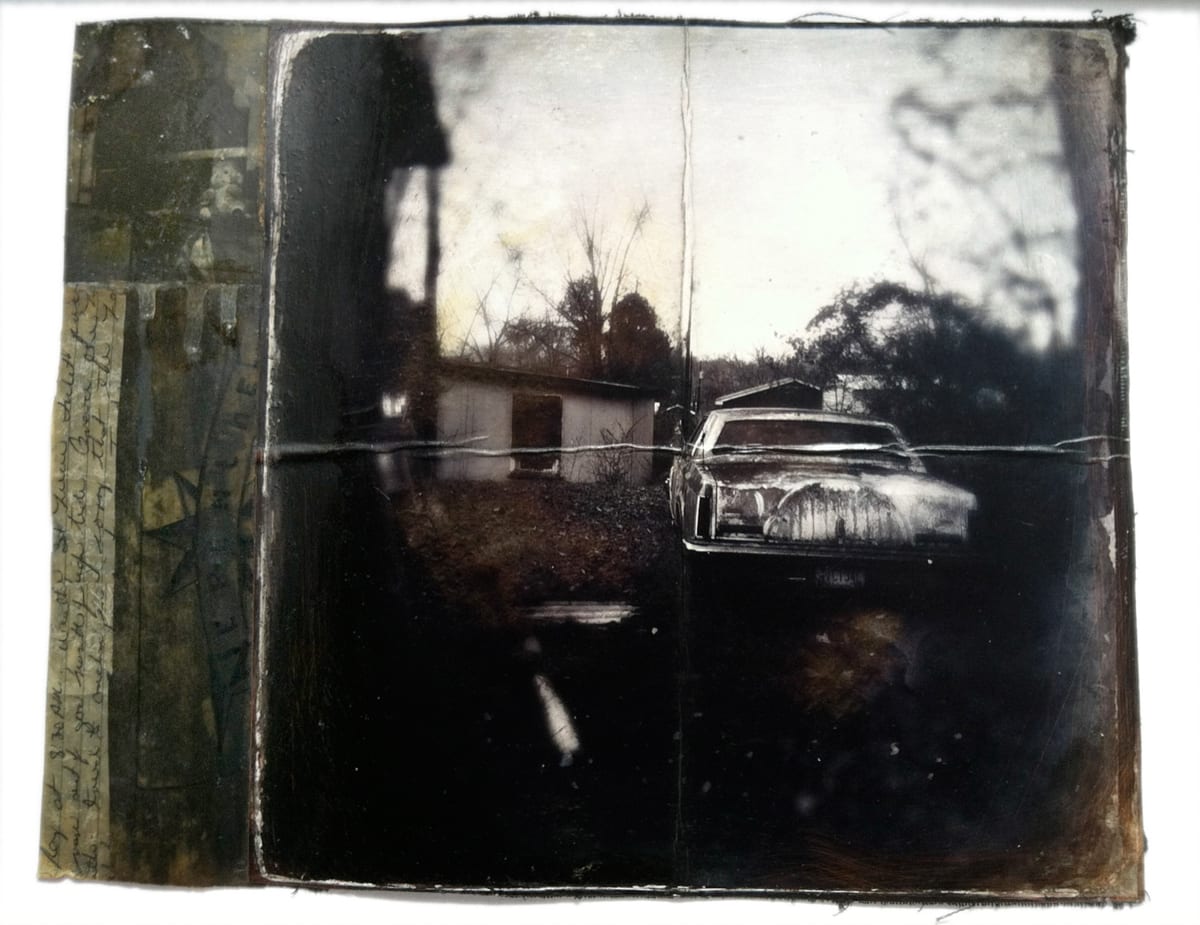
David Diodate talks about becoming an emerging artist at 44, after a nearly 20-year hiatus spent in other careers and then as a stay-at-home Dad. David lives in Birmingham and has shown his work there as well as in Atlanta GA, Greenville SC (Art and Light Gallery), Jackson MS (Fischer Galleries) and Memphis TN.
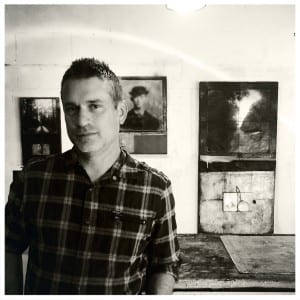
Beth Lilly: First of all, I want to point out how appropriate it is to meet for your interview at a state park halfway between Birmingham and Atlanta so you could bring your son Maddox to play while we talk. A real example of “making things work.”
Secondly, what does the term “emerging artist” mean to you?
David Diodate: You know on Antiques Roadshow when someone brings in a painting by an artist from a school related to a more major artist, the appraiser says “nice work, very accomplished, however…” ? The term “emerging” to me is that “however.” One is still studying, building the work, finding his own voice. For me emerging is starting to exhibit consistently, being accepted into collections, and being awarded for the work. Emerging means struggling and hustling, doing what it takes to get any business off the ground. “Emerging artist” is what many creative people are – folks looking and striving for success in a very crowded field.
BL: Within the last ten years, I’ve met a lot people who started out with a serious art career; they were consistently working, but then the demands of supporting a family, taking care of the kids, these huge responsibilities take their toll and the work slows down to a trickle or stops altogether. Then the kids get older, finances stabilize and they return to their art but with a new maturity.
DD: : I think that’s me. It’s been in spurts and starts. I first started exhibiting in 1992 with a solo show of work at the University of South Florida. From there I showed consistently till ‘95. A failed attempt at grad school derailed my art for years. It was a huge let down for someone who had no clear direction other than being either academic or artistic. I stumbled into the commercial photo lab industry from ‘96 to ‘98. Then in ‘98 I got a job in a corporate photo dept. I occasionally dabbled in my art, showing here and there but nothing very serious until an exhibit at Gallerie MC in ‘05. That exhibit was all my cemetery work from over the previous 10 years. However a new house and a new baby sent art to the back burner again. In ‘08, after leaving corporate America, I started working on small pieces. Not until 2010 did the small works start to develop to a point I felt I could really start exhibiting again. I call this time period the “grad school of myself.” Right now I really feel like a working artist with a website, resume and studio.
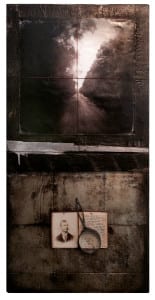
BL: What inspired you to start making art again? What changed in your life?
DD: To be honest I had nothing left as a career. After corporate America, I tried teaching (which I was awful at), then went into retail (which wasn’t much better). I thought about going back to school but the thought of student loans was sickening. I thought back to ‘92 when I had a studio and was working on art. I was so happy. What changed for me is realizing that one has to follow a path that makes them happy. My wife got a great promotion, so that freed me to be a stay-at-home Dad with time to create in the studio.
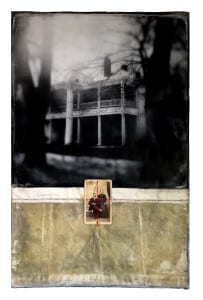
BL: So when you were working or raising your son Maddox, were you experimenting, jotting down ideas, were things brewing in the back of your head or did you let go of photography?
DD: I continued following my inspiration artist, going to museums/galleries, reading the blogs and magazines. I always have ideas brewing. I never let go of photography, but photographing let go of me. 2006 to 2010 were hard years financially. There was no way I could afford film for my old Mamiya, developing, and printing. I had to wait for digital to come to a place I liked and could use.
It’s full speed ahead now and I think ideas I had in ‘92 are still there and are coming to fruition right now. You can look at work from that first show and you could see starts of ideas coming, like re-photographing a photograph or photographing monuments or taking a photograph of a person and distorting it. You can look at my sketchbook and you can see where I kept coming back to it. I’ve always kept a sketchbook and I have a photographic memory so I can lock it away.
BL: And sort of visually work on it in your mind while doing other tasks?
DD: I’ve worked on many an installation in my head. That’s the next step for me. Writing up grants so I can get the money to do more ambitious work – bigger work – bigger studio – even get a camera!
BL: A new camera? What are you using now, didn’t you you say you were using your iPhone?
DD: I use the phone but I shoot through old pieces of glass, magnifying glasses but I also use the apps. I run with those.
BL: Your work is not straight photography. How would you describe it?
DD: Everything in the work is found from the text, to the books, to the old photos; sometimes I use material from my family but very rarely. It all starts with the photograph and works out from there.
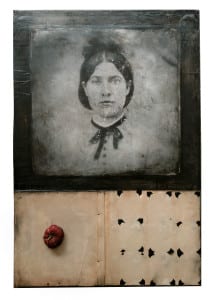
BL: What are these pieces about?
DD: Someone said recently “Southern Gothic.” I’ll take that as a compliment. The work is mostly about Southern places and arcane beauty. When I was little, my grandmother’s home was a 100-year-old farmhouse – dark rooms with dark furniture. I remember her main room off the porch was so dark only small lamps illuminated the table. She would talk on the phone, doodling on everything, all in the dark nest of that room. I think subliminally that’s where the work comes from. Growing up in rural Florida, going three times a year to even more rural area in Georgia. Being an only child and just absorbing all of these Southern images. Dirt roads, pecan orchards, old barns, vintage cars, abandoned places in the middle of fields, women quilting on porches, and time moving slowly one day to the next. Both my grandmother’s house and my great aunt’s cabin were falling apart. Chipping paint, old exposed wood, “diy” fashioned fixes, rust, outer grime. Those memories all come to play in the work. I think of the work as actually being layers of memories.
I’ve kind of divided my work into three sections. The body I’m working on now is called the Trove series and it’s combining the old photography with the text and almost minimalizing it in some regards. There’s a new piece I have, it’s an old plantation house and on the bottom half is an old white textile with an M embroidered on it and I waxed that heavily and I‘ve stitched an old photograph on in the shape of a cross. And I’ve left all the things hanging down off of it. That’s indicative of where I’m going. I’ve minimalized the story, I’ve simplified it, I’ve narrowed it down and I’m really proud of that piece. It’s where I want to go. And I’m working outside the frame now.
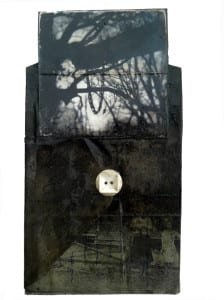
BL: Maddox still is a big responsibility with a lot of demands on your time – how do you handle that?
DD:
Maddox is a great kid. For the most part he likes to be involved in the art. He goes out photographing with me, goes thrifting for objects, sometimes shoots a photo or two. He’s also an only child and very independent. Now that he’s nine, he is very interested in the process. I know when school is in session from 8 to 2 that’s my studio time. I have to have things wrapped up and ideas will have to wait until the next day. 3 pm until bedtime I am on dad time. One has to be realistic in life, I can’t work as an artist 24/7, it’s not a luxury many artists can afford.
You know, I could not do any of this without the support of my family. I mean there is no way. If Lori didn’t say “let’s try this” and my parents said “yeah, well if this is the option we’ve got as a career for you then let’s make it work,” I couldn’t have done any of this. The finances of art are completely expensive and it’s overwhelming. You have to really consider what you are doing and how you are doing it to be an artist. And that goes back to being emerging. I’ve always known you had to be in shows, I always knew you had to cultivate relationships with curators, I always knew that to be taken seriously you have to be with a gallery, and I always knew that in the back of my head. I always put that on the back burner but now I put that front and center as much as the actual creation of the art.
BL: Was there any body of work or any artist that was a catalyst for you?
DD: Rauschenberg’s early combine paintings combining prints and paint and objects. I think you can see that in the work now, that you couldn’t see a few years ago. I’d like to work with a Deardorf and glass plate negatives like Sally Mann but that involves the kind of finances that I just don’t have. Nor the time. It would take me away from the work I actually enjoy doing. I like working in the studio. I like taking a photograph and I like laying it out and thinking of the collage and seeing what kind of story I can put together.
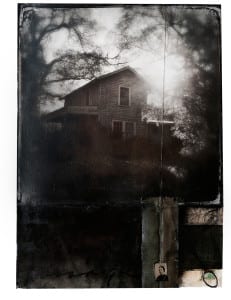
BL: I’ll end with asking you – do you personally collect prints or photo books or both?
DD: I collect photographs. I have a huge collection.
BL: What’s on your walls?
DD: We have a Masao Yamamoto, a Panorama Ray, Donald Robson is on our wall, Simon Larbalestier, and a photographer named Marco Suarez from Greenville SC is one of our favorites.


